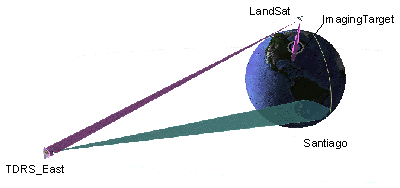Chains and Constellations
The chain (![]() ) and constellation (
) and constellation (![]() ) objects allow you to extend the pair-wise analysis capabilities of STK to include accesses to and from satellite constellations, ground station networks, groups of targets, and multiple sensors. For example, you can determine the time period in which a satellite can see a target and a relay station, and the relay station can see a ground station. You can also group objects together. This is a powerful capability that allows you to compute accesses to an entire group of assets.
) objects allow you to extend the pair-wise analysis capabilities of STK to include accesses to and from satellite constellations, ground station networks, groups of targets, and multiple sensors. For example, you can determine the time period in which a satellite can see a target and a relay station, and the relay station can see a ground station. You can also group objects together. This is a powerful capability that allows you to compute accesses to an entire group of assets.
For example, you can determine when a ground vehicle has access to at least four satellites in the Global Positioning System (GPS) constellation. In addition, you can easily determine when LandSat can see a target and a TDRS relay satellite, and the relay satellite can, in turn, see a ground station. Simply define the chain as:
ImagingTarget – LandSat – TDRS_East – Santiago

You can also solve more sophisticated problems. For example, you could use TDRS-East or TDRS-West as the relay satellite. To model this situation, you would define a constellation of relay satellites and then incorporate that constellation into a chain.
Chains vs. Constellations
Chains are used to determine access through a string of serially linked objects. Constellations allow a single object in the chain to be represented by a defined set of objects.